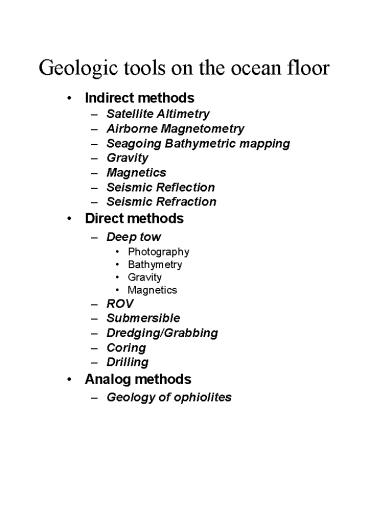Geologic tools on the ocean floor - PowerPoint PPT Presentation
Geologic tools on the ocean floor
Magnetics. Seismic Reflection. Seismic Refraction. Direct methods. Deep tow. Photography ... Magnetics. ROV. Submersible. Dredging/Grabbing. Coring. Drilling ... – PowerPoint PPT presentation
Title: Geologic tools on the ocean floor
1
Geologic tools on the ocean floor
- Indirect methods
- Satellite Altimetry
- Airborne Magnetometry
- Seagoing Bathymetric mapping
- Gravity
- Magnetics
- Seismic Reflection
- Seismic Refraction
- Direct methods
- Deep tow
- Photography
- Bathymetry
- Gravity
- Magnetics
- ROV
- Submersible
- Dredging/Grabbing
- Coring
- Drilling
2
- The Earths crust is divided into 7 major plates
and a number of minor ones.
3
- Plate motions are determined by rotations of the
two plates about a pole (the Euler pole) on a
spherical surface. - Spreading ridges (and magnetic isochrons)
describe great circles that converge at the pole
of rotation. - Transform faults lie on small circles with the
Euler pole - The velocity of rotation is described by ?, given
in degrees per million years.
4
Where ? and ? are the colatitude (90- latitude)
of the Euler pole and the point on the plate
boundary, ? and ? are their respective
longitudes, ? is the rotational velocity in
degrees/million years and a is the radius of the
Earth.
5
Worked example The North America-Pacific plate
boundary in Alaska
If ? is .85 /myr, then ? 36.8 and u 3.2
km/myr (cm/yr).
In San Francisco, the latitude and longitude are
52.2 and -122, with the same pole Then ?30.15
and u2.7 km/myr.
6
Morphology of the ridge axis The primary
determining factor is the spreading rate.
7
Vertical Structure
Seismic structure varies strongly from place to
place.
However, an idealized seismic cross-section of
the crust is still possible.
8
The depth-age correlation is a thermal
phenomenon, due to the cooling of the lithosphere.
9
Rayleigh-Taylor instability
Laboratory experiments suggest that melt
upwelling beneath ridges may be concentrated into
periodically spaced upwelling centers. Geologic
observations were just beginning to arrive at the
same conclusion (Whitehead, et al. 1984).
10
Focussed Accretion
Mantle Bouguer anomaly at the MAR near the Kane
Fracture Zone. Bullseyes indicate zones of hot
melt upwelling (Lin et al., 1990).
11
Axial magma chambers
PowerShow.com is a leading presentation sharing website. It has millions of presentations already uploaded and available with 1,000s more being uploaded by its users every day. Whatever your area of interest, here you’ll be able to find and view presentations you’ll love and possibly download. And, best of all, it is completely free and easy to use.
You might even have a presentation you’d like to share with others. If so, just upload it to PowerShow.com. We’ll convert it to an HTML5 slideshow that includes all the media types you’ve already added: audio, video, music, pictures, animations and transition effects. Then you can share it with your target audience as well as PowerShow.com’s millions of monthly visitors. And, again, it’s all free.
About the Developers
PowerShow.com is brought to you by CrystalGraphics, the award-winning developer and market-leading publisher of rich-media enhancement products for presentations. Our product offerings include millions of PowerPoint templates, diagrams, animated 3D characters and more.































